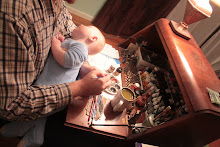Our benevolent overlord (Amazon) got me to bite on a "Lightning deal" recently on a 3d printer. As regular readers of this blog will know, I have been designing 3d models for a while, and have even sold some of them through my storefront on
Shapeways. My kid had been bugging us for a long time about getting a 3d printer (not at all helped by me talking them up for years) and he eventually got my wife to agree that it would be a good learning tool.
So I got an Creality Ender 3, and less than a week later it showed up at the house. I opened it immediately, and after about three hours I had what looked to be a working device. I think I could put together a second one much more quickly, and trying to add a metal extruder without any instructions took up a lot of that time.
Calibration was sort of a pain, and I am not sure I am 100% satisfied, but I am getting close enough to start printing out usable test items.
 |
| I had more than one copy of this "print" |
Since I am working on the American paratroopers at the moment, I naturally thought about printing something for that "army", and after downloading a few suitable files from
Thingiverse, I selected a M5A1 light tank as a starting place, and after manipulating it a bit, I printed it out. This print took around 6.5 hours, although I did not have to be involved, so the time is sort of immaterial.
 |
| M5a1 tank printing out in four pieces |
The tank was printed without a raft, and the front portion had a bit of an adhesion issue, so when I assembled the tank it had a bit of a gap.
 |
| Annoying gap from bed adhesion error |
This is probably something that I would be able to fix, but it was not very satisfying to see this.
After some fiddling about with slicer settings, I tried again, and this time got a much better result.
 |
| Second print, with raft and slower |
 |
| Result of second print of the M5a1, with some plastic bits and a bit of putty. |
The second print was substantially better. Unfortunately satin black plastic does not photograph well, but it is very smooth and aside from the suspension very well detailed. (even the .30 caliber machine gun that I replaced with the M2 was very detailed, just not as good as the plastic one I had) This cost me about $0.80 in materials to print by the way, so certainly cost effective against a traditional metal/resin or even plastic miniature!
I am going to run a few surface finish tests before this particular tank gets painted, so more to come on that.
I have some more testing to do, but I think I am in a place where I can produce usable objects now, and anything bigger than say 5mm cubed will come out pretty nicely.









